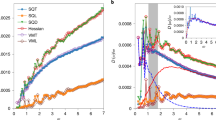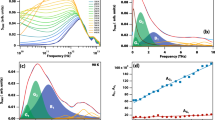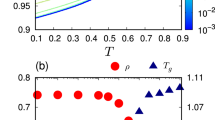Abstract
The boson peak is an excess in the phonon vibrational density of states relative to the Debye model. It has been observed in a wide range of amorphous materials, from inorganic glasses to polymers. Two-dimensional random matrix models and molecular dynamics simulations predict that the boson peak should also be present in amorphous two-dimensional materials, a notion that is of practical importance because it leads to an excess of heat capacity and influences transport properties. However, up until now, experimental observations in actual materials have not been possible due to the limited surface sensitivity of the methods usually applied to measure the boson peak. Here we present the experimental evidence of a boson peak in two-dimensional silica, through phonon spectra measured by means of inelastic helium-atom scattering. We identify the boson peak as a wavenumber-independent spectral maximum at a frequency similar to what has been observed in and predicted for bulk vitreous silica. Furthermore, we present a heterogeneous-elastic theory calculation in two dimensions, which shows how the vibrational coupling of the transversal and flexural shear vertical phonon modes produces the boson peak in two-dimensional materials at a frequency similar to that of the bulk, in agreement with our measurements.
This is a preview of subscription content, access via your institution
Access options
Access Nature and 54 other Nature Portfolio journals
Get Nature+, our best-value online-access subscription
$29.99 / 30 days
cancel any time
Subscribe to this journal
Receive 12 print issues and online access
$209.00 per year
only $17.42 per issue
Buy this article
- Purchase on Springer Link
- Instant access to full article PDF
Prices may be subject to local taxes which are calculated during checkout





Similar content being viewed by others
Data availability
The experimental dataset is available via DataverseNO at https://doi.org/10.18710/CMKTQX (ref. 78).
References
Debye, P. Zur Theorie der spezifischen Wärme. Ann. Phys. 344, 789–839 (1912).
Malinovsky, V. K. & Sokolov, A. P. The nature of boson peak in Raman scattering in glasses. Solid State Commun. 57, 757–761 (1986).
Buchenau, U. et al. Low-frequency modes in vitreous silica. Phys. Rev. B 34, 5665–5673 (1986).
Chumakov, A. I. et al. Collective nature of the boson peak and universal transboson dynamics of glasses. Phys. Rev. Lett. 92, 245508 (2004).
Elliott, S. R. A unified model for the low-energy vibrational behaviour of amorphous solids. Europhys. Lett. 19, 201 (1992).
Buchenau, U. Amorphous materials: low-frequency vibrations. in Encyclopedia of Materials: Science and Technology 212–215 (Elsevier, 2001).
Pohl, R. O. Amorphous materials: heat capacity. in Encyclopedia of Materials: Science and Technology 194–197 (Elsevier, 2001).
Zeller, R. C. & Pohl, R. O. Thermal conductivity and specific heat of noncrystalline solids. Phys. Rev. B 4, 2029–2041 (1971).
Schirmacher, W. Thermal conductivity of glassy materials and the ‘boson peak’. Europhys. Lett. 73, 892–898 (2006).
Beltukov, Y. M., Parshin, D. A., Giordano, V. M. & Tanguy, A. Propagative and diffusive regimes of acoustic damping in bulk amorphous material. Phys. Rev. E 98, 023005 (2018).
Jäckle, J. in Amorphous Solids: Low-Temperature Properties (ed Phillips, W. A.) 135 (Springer, 1981).
Duval, E., Boukenter, A. & Achibat, T. Vibrational dynamics and the structure of glasses. J. Phys.: Condens. Matter 2, 10227 (1990).
Kabeya, M. et al. Boson peak dynamics of glassy glucose studied by integrated terahertz-band spectroscopy. Phys. Rev. B 94, 224204 (2016).
Baldi, G., Giordano, V. M. & Monaco, G. Elastic anomalies at terahertz frequencies and excess density of vibrational states in silica glass. Phys. Rev. B 83, 174203 (2011).
Schroeder, J., Lee, M., Saha, S. K. & Persans, P. D. Raman scattering in glasses at high temperature: the boson peak and structural relaxation kinetics in glasses. J. Non-Cryst. Solids 222, 342–347 (1997).
Hutt, K. W., Phillips, W. A. & Butcher, R. J. Far-infrared properties of dilute hydroxyl groups in an amorphous silica matrix. J. Phys.: Condens. Matter 1, 4767–4772 (1989).
Ohsaka, T. & Ihara, T. Far-infrared study of low-frequency vibrational states in As2S3 glass. Phys. Rev. B 50, 9569–9572 (1994).
Benassi, P. et al. Evidence of high frequency propagating modes in vitreous silica. Phys. Rev. Lett. 77, 3835–3838 (1996).
Buchenau, U., Nücker, N. & Dianoux, A. J. Neutron scattering study of the low-frequency vibrations in vitreous silica. Phys. Rev. Lett. 53, 2316 (1984).
Wischnewski, A., Buchenau, U., Dianoux, A. J., Kamitakahara, W. A. & Zarestky, J. L. Neutron scattering analysis of low-frequency modes in silica. Philos. Mag. B 77, 579–589 (1998).
Buchenau, U. Neutron scattering investigations of the boson peak. Condens. Matter Phys. 22, 43601 (2019).
Mori, T. et al. Detection of boson peak and fractal dynamics of disordered systems using terahertz spectroscopy. Phys. Rev. E 102, 022502 (2020).
Tomoshige, N., Mizuno, H., Mori, T., Kim, K. & Matubayasi, N. Boson peak, elasticity, and glass transition temperature in polymer glasses: effects of the rigidity of chain bending. Sci. Rep. 9, 19514 (2019).
White, G. K., Collocott, S. J. & Cook, J. S. Thermal expansion and heat capacity of vitreous B2O3. Phys. Rev. B 29, 4778–4781 (1984).
Fultz, B., Ahn, C. C., Alp, E. E., Stuhrhahn, W. & Toellner, T. S. Phonons in nanocrystalline 57Fe. Phys. Rev. Lett. 79, 937 (1997).
Kara, A. & Rahman, R. S. Vibrational properties of metallic nanocrystals. Phys. Rev. Lett. 81, 1453 (1998).
Perlich, J. et al. Grazing incidence wide angle X-ray scattering at the wiggler beamline BW4 of HASYLAB. Rev. Sci. Instrum. 81, 105105 (2010).
Müller-Buschbaum, P. Grazing incidence small-angle neutron scattering: challenges and possibilities. Polym. J. 45, 34–42 (2012).
Steurer, W. et al. Observation of the boson peak at the surface of vitreous silica. Phys. Rev. Lett. 99, 035503 (2007).
Steurer, W. et al. Surface dynamics measurements of silica glass. Phys. Rev. B 78, 045427 (2008).
Steurer, W. et al. Anomalous phonon behavior: blueshift of the surface boson peak in silica glass with increasing temperature. Phys. Rev. Lett. 100, 135504 (2008).
Steurer, W. et al. Vibrational excitations of glass observed using helium atom scattering. J. Phys.: Condens. Matter 20, 224003 (2008).
Alderwick, A. R., Jardine, A. P., Allison, W. & Ellis, J. An evaluation of the kinematic approximation in helium atom scattering using wavepacket calculations. Surf. Sci. 678, 65–71 (2018).
Holst, B. et al. Material properties particularly suited to be measured with helium scattering: selected examples from 2D materials, van der Waals heterostructures, glassy materials, catalytic substrates, topological insulators and superconducting radio frequency materials. Phys. Chem. Chem. Phys. 23, 7653–7672 (2021).
Chen, K. et al. Low-frequency vibrations of soft colloidal glasses. Phys. Rev. Lett. 105, 025501 (2010).
Zhang, L. et al. Experimental studies of vibrational modes in a two-dimensional amorphous solid. Nat. Commun. 8, 67 (2017).
Wang, Y., Hong, L., Wang, Y., Schirmacher, W. & Zhang, J. Disentangling boson peaks and Van Hove singularities in a model glass. Phys. Rev. B 98, 174207 (2018).
Cortie, D. L. et al. Boson peak in ultrathin alumina layers investigated with neutron spectroscopy. Phys. Rev. Res. 2, 023320 (2020).
Karpov, V. G., Klinger, M. I. & Ignat’ev, F. N. Theory of the low-temperature anomalies in the thermal properties of amorphous structure. Zh. Eksp. Teor. Fiz. 84, 775 (1983).
Buchenau, U., Galperin, Y. M., Gurevich, V. L. & Schober, H. R. Anharmonic potentials and vibrational localization in glasses. Phys. Rev. B 43, 5039–5045 (1991).
Buchenau, U. et al. Interaction of soft modes and sound waves in glasses. Phys. Rev. B 46, 2798–2808 (1992).
Parshin, D. A. Soft potential model and universal properties of glasses. Phys. Scr. T49A, 180–185 (1993).
Guillot, B. & Guissani, Y. Boson peak and high frequency modes in amorphous silica. Phys. Rev. Lett. 78, 2401–2404 (1997).
Horbach, J., Kob, W. & Binder, K. High frequency sound and the boson peak in amorphous silica. Eur. Phys. J. B 19, 531–543 (2001).
Wang, C., Tamai, Y. & Kuzuu, N. A molecular dynamics study on vibration spectra of a-SiO2 surface. J. Non-Cryst. Solids 321, 204–209 (2003).
Maurer, C. & Schirmacher, W. Local oscillators vs. elastic disorder: a comparison of two models for the boson peak. J. Low-Temp. Phys. 137, 453–470 (2004).
Marruzzo, A., Schirmacher, W., Fratalocchi, A. & Ruocco, G. Heterogeneous shear elasticity of glasses: the origin of the boson peak. Sci. Rep. 3, 1407 (2013).
Tanguy, A., Wittmer, J.-P. & Barrat, J.-L. Continuum limit of amorphous elastic bodies: a finite-size study of low-frequency harmonic vibrations. Phys. Rev. B 66, 174205 (2002).
Maloney, C. & Lemaître, A. Universal breakdown of elasticity at the onset of material failure. Phys. Rev. Lett. 93, 195501 (2004).
Léonforte, F., Tanguy, A., Wittmer, J. P. & Barrat, J.-L. Continuum limit of amorphous elastic bodies II: linear response to a point source force. Phys. Rev. B 70, 014203 (2004).
Léonforte, F., Boissière, R., Tanguy, A., Wittmer, J. P. & Barrat, J.-L. Continuum limit of amorphous elastic bodies III: three-dimensional systems. Phys. Rev. B 72, 224206 (2005).
Léonforte, F., Tanguy, A., Wittmer, J. P. & Barrat, J.-L. Inhomogeneous elastic response of silica glass. Phys. Rev. Lett. 97, 055501 (2006).
Pan, Z. et al. Disorder classification of the vibrational spectra of modern glasses. Phys. Rev. B 104, 134106 (2021).
Shintani, H. & Tanaka, H. Universal link between the boson peak and transverse phonons in glass. Nat. Mater. 7, 870–877 (2008).
Beltukov, Y. M., Fusco, C., Parshin, D. A. & Tanguy, A. Theory of sparse random matrices and vibrational spectra of amorphous solids. Phys. Rev. E 93, 023006 (2016).
Hu, Y.-C. & Tanaka, H. Origin of the boson peak in amorphous solids. Nat. Phys. 18, 669–677 (2022).
Schirmacher, W., Diezemann, G. & Ganter, C. Harmonic vibrational excitations in disordered solids and the ‘boson peak’. Phys. Rev. Lett. 81, 136 (1998).
Beltukov, Y. M. & Parshin, D. A. Theory of sparse random matrices and vibrational spectra of amorphous solids. Phys. Solid State 53, 151–162 (2011).
Conyuh, D. A., Beltukov, Y. M. & Parshin, D. A. Boson peak in two-dimensional random matrix models. J. Phys. Conf. Ser. 929, 012031 (2017).
Conyuh, D. A. & Beltukov, Y. M. Random matrix theory and the boson peak in two-dimensional systems. Phys. Solid State 62, 689–695 (2020).
Raikov, I. O., Conyuh, D. A., Ipatov, A. N. & Parshin, D. A. Boson peak in amorphous graphene in the stable random matrix model. Phys. Solid State 62, 2143–2153 (2020).
Büchner, C. et al. A large-area transferable wide band gap 2D silicon dioxide layer. ACS Nano 10, 7982–7989 (2016).
Büchner, C. & Heyde, M. Two-dimensional silica opens new perspectives. Prog. Surf. Sci. 92, 341–374 (2017).
Huang, P. Y. et al. Direct imaging of a two-dimensional silica glass on graphene. Nano Lett. 12, 1081–1086 (2012).
Huang, P. Y. et al. Imaging atomic rearrangements in two-dimensional silica glass: watching silica’s dance. Science 342, 224–227 (2013).
Büchner, C. et al. Bending rigidity of 2D silica. Phys. Rev. Lett. 120, 226101 (2018).
Hofmann, F. & Toennies, J. P. High-resolution helium atom time-of-flight spectroscopy of low-frequency vibrations of adsorbates. Chem. Rev. 96, 1307–1326 (1996).
Ashcroft, N. W. & Mermin, N. D. Solid State Physics (Harcourt College Publishers, 1976).
Apfolter, A. Wiederaufbau und Test einer He-Streuapparatur und erste Streuexperimente an amorpher sowie kristalliner SiO2 Oberfläche. Master’s thesis, Graz University of Technology (2005).
Eder, S. D., Samelin, B., Bracco, G., Ansperger, K. & Holst, B. A free jet (supersonic), molecular beam source with automatized, 50 nm precision nozzle-skimmer positioning. Rev. Sci. Instrum. 84, 093303 (2013).
Koleske, D. D. & Sibener, S. J. Generation of pseudorandom sequences for use in cross-correlation modulation. Rev. Sci. Instrum. 63, 3852–3855 (1992).
Huang, Y., Wu, J. & Hwang, K. C. Thickness of graphene and single-wall carbon nanotubes. Phys. Rev. B 74, 245413 (2006).
Yang, B. et al. Thin silica films on Ru(0001): monolayer, bilayer and three-dimensional networks of [SiO4] tetrahedra. Phys. Chem. Chem. Phys. 14, 11344–11351 (2012).
Schirmacher, W., Scopigno, T. & Ruocco, G. Theory of vibrational anomalies in glasses. J. Non-Cryst. Solids 407, 133–140 (2015).
Amorim, B. & Guinea, F. Flexural mode of graphene on a substrate. Phys. Rev. B 88, 115418 (2013).
Goodman, F. O. & Wachman, H. Y. Quantum theory of gas-surface scattering. in Dynamics of Gas-Surface Scattering 143–180 (Elsevier, 1976).
Beeby, J. L. The scattering of helium atoms from surfaces. J. Phys. C: Solid State Phys. 4, 359–362 (1971).
Holst, B., Eder, S. D. & Tømterud, M. Helium atom scattering on amorphous bilayer silica; https://doi.org/10.18710/CMKTQX
Acknowledgements
We want to specially thank H.-J. Freund and M. Heyde for making the 2D silica sample available for these experiments. We also thank W. Steurer for useful discussions and acknowledge the valuable contributions and stimulating discussions with G. Pacchioni. L.W. acknowledges funding from the Carl Zeiss Foundation through its breakthrough program. B.H. acknowledges funding from the Research Council of Norway (project nos. 213453 and 234159), both within the FRIPRO program. M.T. acknowledges funding from the Research Council of Norway (project no. 337339) (travel support).
Author information
Authors and Affiliations
Contributions
C.B. prepared the sample, S.D.E. performed the experiments and M.T. performed the data analysis. L.W. and W.S. provided the theoretical model. I.S. and J.R.M. supported the analysis. B.H. designed the experiments. M.T., J.R.M. and B.H. wrote the paper with contributions from all authors.
Corresponding authors
Ethics declarations
Competing interests
The authors declare no competing interests.
Peer review
Peer review information
Nature Physics thanks Anne Tanguy, Talat Rahman and Hideyuki Mizuno for their contribution to the peer review of this work.
Additional information
Publisher’s note Springer Nature remains neutral with regard to jurisdictional claims in published maps and institutional affiliations.
Rights and permissions
Springer Nature or its licensor (e.g. a society or other partner) holds exclusive rights to this article under a publishing agreement with the author(s) or other rightsholder(s); author self-archiving of the accepted manuscript version of this article is solely governed by the terms of such publishing agreement and applicable law.
About this article
Cite this article
Tømterud, M., Eder, S.D., Büchner, C. et al. Observation of the boson peak in a two-dimensional material. Nat. Phys. 19, 1910–1915 (2023). https://doi.org/10.1038/s41567-023-02177-2
Received:
Accepted:
Published:
Issue Date:
DOI: https://doi.org/10.1038/s41567-023-02177-2



